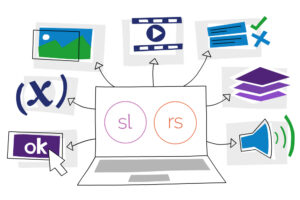
Break Down Complex Content for Effective Learning
Have you ever been handed a massive PowerPoint deck, a policy document, or a stack of SME notes and told, “Can you turn this into a quick online course?” If you have, you know that first feeling a mix of where do I start? and how will I make this interesting?
The truth is good eLearning design doesn’t start with all the information you have. It starts with knowing what’s essential and how to make it easy for learners to understand.
That’s where the process of breaking down content comes in.
Instructional designers often call this chunking, the simple but powerful act of grouping related ideas into small, meaningful sections that make sense to learners. When you do it well, your content starts to flow. It’s easier to follow, easier to remember, and a lot more enjoyable to experience.
In this post, we’ll look at how to break down complex content step by step and why this technique is one of the core skills we teach in our eLearning Design Essentials Workshop.
What Does “Breaking It Down” Really Mean?
Let’s clear up a common myth. Breaking down content isn’t just about making it shorter.
It’s about creating structure and meaning.
Think of your course like a story. A story doesn’t just stop every few pages, it has chapters. Each chapter focuses on one key part of the journey and connects to the next.
In eLearning, breaking content down works the same way. Each section (or chunk) should focus on one idea, concept, or action. When you give learners one thing to focus on at a time, they can build understanding step by step.
Chunking isn’t about cutting. It’s about connecting.
It’s how we help learners make sense of big ideas without feeling overwhelmed.
Why It Matters
Our brains can only process a few new ideas at once. When we present everything together, learners quickly lose track of what’s important.
By breaking content down, we give learners mental breathing room. They can focus on one concept, understand it, and then move to the next.
Breaking content down also helps:
- Reduce cognitive overload – learners see one idea at a time.
- Build confidence – progress feels achievable.
- Create flow – each step feels like a natural next move.
It all starts with empathy, understanding what your learners actually need and care about. If you’d like a framework for that, check out our post on Using Design Thinking to Connect with Your Audience.
In short: it helps people learn without feeling lost.
Step 1: Estimate Before You Design
Before you start editing or building screens, take a moment to estimate the scale of what you’re working with.
If you dive straight into Storyline or Rise, it’s easy to overbuild or underestimate how much content you’re trying to fit in. Estimating first helps you see the size of your mountain before you start climbing.
Here’s a simple guide that many workplace learning teams use when converting facilitator-led training into self-paced eLearning:
| In-Person Session Duration | Typical eLearning Equivalent | Notes |
|---|---|---|
| 1 hour | 15 – 20 minutes | Varies based on interactivity and assessment depth |
| Half-day (3–4 hrs) | 40 minutes | Moderate interactivity with some branching |
| Full day (6–8 hrs) | 1.5 – 2.5 hours | Highly interactive, scenario-based learning |
| 2 days (12–16 hrs) | 3 – 4 hours | Often delivered as modular or pathway experiences |
💡 These ratios are based on B Online Learning’s experience delivering hundreds of corporate eLearning projects, supported by broader industry ranges published by ATD and Chapman Alliance.
In workplace learning, efficiency matters. Modern instructional design focuses on clarity, relevance and flow, rather than time spent in the seat. When you focus on performance outcomes not just information — learners can often achieve the same results in a fraction of the time.
Using these ratios helps you set realistic expectations early, plan project scope, and design with impact in mind.
Step 2: Group Related Ideas
Once you have a rough sense of size, look for logical groupings.
Group information by meaning, not by how it appears in your source material.
For example, imagine you have a policy document that covers background, responsibilities, rules, and exceptions. Instead of following that structure, you might group content like this:
- Why this policy matters – the big picture.
- What it means for you – the practical steps.
- What to do in real situations – examples or scenarios.
- Where to go for help – resources or next steps.
Suddenly, the same content now feels like a journey. Each section helps learners understand not just what the policy says, but why it matters to them.
Step 3: Give Each Section a Rhythm
Good courses have a rhythm, a predictable pattern that helps learners feel comfortable and engaged.
Try using a structure like this within each section:
Introduce → Explain → Example → Reflect → Apply
This creates a learning flow that feels natural. You introduce a concept, explain it simply, show it in action, let learners think about it, and then give them a way to apply or check their understanding.
Consistency like this makes even complex topics feel manageable.
Step 4: Build Bridges Between Sections
Each section should connect to the next.
Without transitions, your course can feel like a bunch of disconnected slides. Try adding short linking statements, like:
“Now that you understand how this policy applies to you, let’s see what to do in different situations.”
Or use simple visuals like progress bars, step indicators, or icons to show how the learner is moving through the journey.
These small touches make a big difference to how seamless your course feels.
Step 5: Review and Refine
When you’ve grouped and sequenced your content, step back and check:
- Does each section have a clear purpose?
- Are any sections too long or too short?
- Does the flow make sense from the learner’s perspective?
This review step is also a great time to involve your SME. When they see how the content has been broken down, they can confirm what’s essential and what could move to a reference link or resource.
If you’re looking for ways to make those conversations smoother, take a look at Tips to Work Effectively with Subject Matter Experts
A Quick Before-and-After Example
Here’s a simple way to see the difference this makes:
Before: A single 3,000-word document full of policy rules and definitions.
After:
- Why the policy matters
- What you’re responsible for
- Common examples
- What to do if unsure
- Where to find more information
We used a similar approach in a recent client project, turning dense policy documents into a clear, interactive learning experience built in Articulate Rise.
🔗 Read how we brought those policies to life.
Same content. New structure. And a far more engaging learning experience.
Common Pitfalls to Avoid
- Breaking by size instead of meaning.
- Using original document headings.
- Creating too many micro-sections with no flow.
- Not always testing your sequence with real users.
Once your structure feels right, your words bring it to life. Learn how to write with clarity and flow in our guide to Writing for eLearning: Tips and Best Practices
Ask yourself: does this structure make learning easier or harder?
Learn How to Break It Down Like a Pro
Breaking content down (or chunking) might seem simple, but it’s one of the hardest parts of instructional design to master. It’s about seeing patterns, knowing what to keep, and designing flow that makes sense to learners. For a deeper dive into how all these pieces fit together – from planning to writing – explore our guide, From Content Dump to Curated Journey
That’s also why we focus on this skill in our eLearning Design Essentials Workshop.
In this hands-on session, you’ll learn how to:
- Break down dense subject matter step by step
- Map a clear learning journey that flows
- Write in a way that guides learners through complex ideas
- Collaborate with SMEs to simplify content early
You’ll leave with a clear process you can use on any project from compliance courses to onboarding programs.
Turn your next content dump into a curated, learner-friendly experience. one clear step at a time.
Source link



